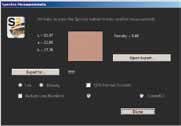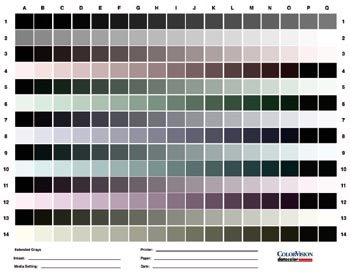articles/Printing/spyder3print-page2
Datacolour Spyder 3 Print - part 2 of 1 2
by Mike McNamee Published 01/04/2009

On the fourth attempt we made a profile that passed the initial Granger Chart examination and we moved on to colour-audit the outcome. We had deliberately chosen a non-Epson paper so that the profile had some work to do, picking the Costco Kirkland paper. This is a cool blue base tone paper, high gloss and with a moderate amount of optical brighteners.
The comparison boils down to a shoot out between taking this 'rogue' paper and running it with the installed Epson profile and putting it up against the bespoke profile made with the Spyder. The mean statistical error values were quite similar, 4.34?E2000 for the Epson profile and 4.67 for the Spyder profile. However, as always, the devil is in the detail. The major component of the Spyder error was in the lightness channel.
Across the Macbeth Swatch set, the average lightness value was 5% too dark. At this stage, the software provided with the Spyder comes into play. You can edit the profiles, a facility that only comes available on competing systems at a much higher price. We dialled in a 'minus 10' on the Brightness slider (see screen grab) and re-ran the audit to obtain a result within a hundredth of a point of the aim lightness average, with a corresponding tumbling of the other statistical errors (see table for detail). Significantly the white differentiation of the audit print was retained, the brightness tuned only the mid-tones (as we would have hoped). Overall the audit print was very good quality. The skin tone saturation, which is typically depressed by the profiling process, held up well and once the lightness was corrected, very accurate skin tones were created. The average error was reduced below 3.0 ?E2000 across the Macbeth set, always a good sign!
The table displays the errors for various colour sets. Every value is improved (lowered) in the right column using the Spyder profile with a tweak to the brightness.

Spot Colour Measuring
As a diagnostic tool, the ability to measure a colour takes some beating, but you first have to get to understanding Lab measurements. For our part we measured the same Macbeth Chart with both the Spyder and an X-rite DTP 22 Spectrophotometer. The Help files of the Spyder were silent on the matter of colour temperature so we are unsure of the temperature at which the Spyder is calibrated. We tested the calibration at both D65 and D50. The residual average differences across the Macbeth Chart were 3.50 and 2.32 Lab ?E. This is the average error, the maximum recorded values were 13.7 and 6.7 Lab ?E. These error values are considerably larger than the demands for professional contract proofing. Even so the usefulness of spot measuring should not be underestimated when you are trying to assess the merits of a particular reference print. If you take our testing of the Spyder as an example, once we had ascertained that the Lightness parameter was down by 5% we knew exactly what we had to do to amend the profile. If we had not taken a spot measurement we would have had to guess a correction and then iterate towards the answer over a series of prints.
Summary
At £339.99 RRP (but available from Colour Confidence at £228) the unit is quite a sound investment for somebody who wishes to step outside of the OEM paper/ink set-ups. We tested the Spyder against our (very expensive) spectrophotometers and found it to be accurate enough for everyday professional photography use. The claim on the box of the Spyder being a tool for 'production professionals' is a little far-fetched. It has no CMYK, linearisation or ink limit facilities, it is miles too slow and the accuracy is a little off for contract proof work (not surprising at this price point, you need an investment of thousands to get up into that sort of territory!). Building a decent profile needs the larger patch targets to be used; there was detectable banding in the Granger Chart from the smaller target. Many enthusiasts, however, will be prepared to devote the time and effort to tuning their output.
The Spyder is also equipped with the facility to fine-tune monochrome output and even interfaces with the QuadTone RIP (www.quadtonerip. com). This is much beloved by the black and white printing fraternity and there is a lot of discussion and advice on the use of the Spyder on their forum, especially for use with the Quad Black ink solutions (http://tech.groups.yahoo.com/group/DigitalBlackandWhiteThePrint/). For those with the time to tinker, this is an endless source of entertainment; we stormed off in a sulk when the measuring wizard ditched our hardearned work and asked us to go back and start again. The 'Advanced Black and White' driver that is built in to the Epson system removes the need to tune monochrome output with outside devices as all the facilities you could wish for are already present.
Please Note:
There is more than one page for this Article.
You are currently on page 2 Contact Mike McNamee
1st Published 01/04/2009
last update 21/07/2022 08:46:26
More Printing Articles
There are 19 days to get ready for The Society of Photographers Convention and Trade Show at The Novotel London West, Hammersmith ...
which starts on Wednesday 14th January 2026










